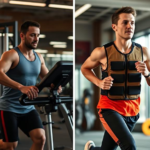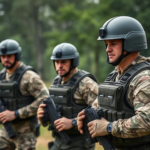
Weighted Vest Equipment: What to use with Your Weighted Vest
Ignite Your Workout: Key Insights for Weighted Vest Training
Strategic Resistance: A weighted vest isn’t just about adding weight; it’s a versatile tool that elevates nearly any exercise, from bodyweight movements to cardio, by forcing your body to work harder and smarter.
Complementary Equipment: Pairing your weighted vest with gear like dip belts, resistance bands, and supportive footwear amplifies your results, allowing for targeted strength gains and enhanced overall performance.
Progressive Overload & Comfort: Begin with a lighter vest (4-10% of body weight) and gradually increase the load. Prioritize a snug, adjustable, and breathable vest to ensure comfort and prevent injury, making your workouts more effective and enjoyable.
Why a Weighted Vest is Your Next Best Training Partner
When your bodyweight exercises start feeling too easy, or your runs just aren’t challenging enough, a weighted vest steps in. It’s an amazing tool for something called progressive overload—that fancy term for gradually increasing the demands on your body to keep getting stronger. The vest adds consistent resistance, making your muscles work harder, which means faster gains in strength and endurance.
And it’s not just about muscle! Many experts (myself included, after seeing the results) agree that using a weighted vest can seriously boost your cardiovascular conditioning. Plus, studies suggest it can increase calorie expenditure and even improve bone density by putting healthy, beneficial stress on your bones. What’s not to love about that?
The Core Principle: Smart Resistance for Superior Gains
The real magic of a weighted vest lies in its ability to seamlessly integrate extra weight into movements you already perform. Unlike holding dumbbells, which can feel awkward for certain exercises, the vest distributes weight evenly around your torso. This creates a more natural and integrated resistance, allowing for a balanced challenge across various movements. It truly elevates your workout, making even familiar exercises significantly more demanding and effective.
When you’re choosing your vest, pay close attention to the weight. It’s crucial. I’ve found that starting lighter—around 4-10% of your body weight—and gradually increasing as you get stronger is the safest and most effective strategy. This methodical approach allows your body to adapt, helping to prevent injury and ensuring consistent progress. Many high-quality vests, like those from Hyperwear or GORUCK, offer removable weights, often in small increments, which is perfect for this progressive approach.
Essential Equipment to Pair with Your Weighted Vest
Now, for the exciting part: let’s talk about what other gear can truly supercharge your weighted vest training. These aren’t just random add-ons; they’re strategic tools that amplify your efforts and open up new dimensions of challenge.
Unleash Your Bodyweight Power: The Classic Combo
This is where the weighted vest truly shines. It takes classic bodyweight exercises and elevates them to an entirely new level of intensity. Imagine turning up the volume on your routine:
Push-ups & Pull-ups: A New Dimension of Strength
Suddenly, your chest, triceps, and back are screaming in the best possible way. While a dip belt is fantastic for adding serious weight to pull-ups and dips, a well-fitting weighted vest provides a more integrated challenge, making these fundamental exercises significantly harder. Some advanced vests, like the Kensui EZ-Vest, are even compatible with standard weight plates, allowing for massive loads up to 150kg for those deep into weighted calisthenics.Squats & Lunges: Building a Powerful Foundation
You’re building stronger legs and glutes without needing a barbell, simply by adding constant resistance to every rep. The even weight distribution of the vest makes these movements feel more natural and balanced.Planks & Core Work: Engaging Your Midsection
The added weight forces your core to engage even more intensely, leading to greater activation of your abdominal and back muscles. This helps build a rock-solid core, essential for all movements.Jumps & Explosive Movements: Dynamic Resistance
For explosive athleticism, a lighter vest can add just enough resistance to make your jumps and plyometric drills more demanding, building power and quickness with each movement.
Enhancing Your Upper Body: The Power of a Dip Belt
If you’re serious about taking your weighted pull-ups and dips to the next level, a dip belt is an absolute gem. While your weighted vest provides a fantastic overall challenge, a dip belt allows you to attach substantial barbell plates, offering more precise and often heavier loading for these specific upper body movements. I’ve found that dip belts offer a more targeted way to load these exercises because the weight hangs below your waist, providing a different feel and allowing for greater weight capacity than many vests alone. Discussions in bodyweight fitness communities, like those on Reddit, consistently highlight the effectiveness of dip belts for weighted pull-ups, praising their freedom of movement and scalability for serious strength gains.
The Science of Support: Footwear for Weighted Training
If your plan involves running, walking, or rucking with your weighted vest, please don’t overlook your footwear! The added weight amplifies the forces on your feet, ankles, and knees. A quality pair of well-cushioned and supportive running or trail shoes becomes absolutely essential to absorb impact and prevent injuries. Think of your shoes as the foundation of your weighted vest workout—you wouldn’t build a strong house on shaky ground, right? Brands like ASICS emphasize breathable and supportive designs for weighted running, ensuring comfort and stability.
Dynamic Tension: Resistance Bands
Here’s where things get really interesting for seasoned fitness enthusiasts: combining weighted vests with resistance bands. Resistance bands add a dynamic form of tension that changes throughout the range of motion. This means your muscles are challenged differently compared to pure weighted movements, leading to unique stimulus and enhanced muscle fatigue. Imagine doing banded push-ups or squats while wearing a weighted vest – the combination creates a multi-dimensional challenge, building strength and power more effectively. Plus, it’s a low-impact option that can be easily scaled. While bands don’t physically attach to the vest, they are a powerful complementary tool in your training arsenal.
Staying Hydrated: The Unsung Hero
When you add extra weight, your body works harder, and that means more sweat! Having a reliable water bottle or a hydration pack nearby is an absolute must. Trust me, staying hydrated is crucial for maintaining performance and preventing fatigue, especially during longer sessions or intense cardio with your vest.
Track Your Progress: Fitness Trackers & Apps
This isn’t “equipment” in the traditional sense, but wearable tech can be a surprisingly powerful partner in your weighted vest journey. Fitness trackers that monitor heart rate, calories burned, and workout intensity help you understand just how much your vest is ramping things up. Some apps even offer custom workouts or interval timers tailored for weighted training. Tracking your progress digitally keeps you motivated—and accountable, which makes a huge difference in staying consistent.
Optimizing Your Weighted Vest Experience: Fit, Adjustability, and Durability
Beyond the additional gear, the quality and fit of your weighted vest itself are paramount for comfort, effectiveness, and longevity. An ill-fitting vest can cause discomfort, chafing, or even alter your natural movement patterns, negating the benefits of your workout.
The Importance of a Snug and Secure Fit
Seriously, an uncomfortable vest will just sit in your closet. Look for vests that adjust at the shoulders and waist, allowing for a custom-like fit. A snug vest prevents bouncing and shifting during dynamic movements like running or jumping, allowing you to focus on your exercise rather than adjusting your gear. Vests designed with specific body types in mind, such as the Empower Weighted Vest for women or the Hyperwear Hyper Vest Elite known for its thin profile and secure lace-up design, often provide superior comfort.
Adjustability: Tailoring the Load to Your Progress
As your strength improves, you’ll naturally want to increase the resistance. Vests with removable weights, often in small increments (e.g., 1-2 lbs), are ideal for long-term use and progressive overload. This allows you to fine-tune the load precisely, whether you’re adding just a little extra for a brisk walk or significantly increasing it for weighted pull-ups. Many tactical-style vests also accept standard steel or iron plates, offering a vast range of adjustability.
Material and Durability: Built to Last
Since you’ll be sweating in these, look for durable, breathable, and sweat-wicking materials. Top-tier vests often utilize ballistic nylon or Cordura, known for their exceptional longevity and resistance to wear and tear. Breathable fabrics like Lycra or mesh are also crucial for ventilation, especially during longer or more intense sessions.
Frequently Asked Questions About Weighted Vest Equipment
What is the ideal starting weight for a weighted vest?
Generally, starting with a weighted vest that is 4-10% of your body weight is recommended. For example, if you weigh 150 pounds, a 6-15 pound vest would be a good starting point. The key is to begin light and gradually increase the weight as your strength and endurance improve, allowing your body to adapt safely.
Can I use a weighted vest for running or cardio?
Yes, absolutely! Weighted vests can significantly enhance cardio workouts like running, walking, or rucking by increasing resistance and calorie expenditure. However, it’s crucial to choose a vest specifically designed for running—one that is snug, breathable, sweat-wicking, and doesn’t bounce or chafe. Also, ensure you wear supportive footwear to protect your joints from the added impact.
Is a dip belt necessary if I have a weighted vest?
While a weighted vest can add resistance to pull-ups and dips, a dip belt is highly recommended if you’re serious about progressive overload for these specific exercises. Dip belts allow you to attach much heavier barbell plates, often exceeding the maximum weight of many vests, providing more targeted and substantial resistance for strength gains in your upper body.
How often should I train with a weighted vest?
The frequency of weighted vest training depends on your fitness level, the intensity of your workouts, and your recovery capacity. For beginners, incorporating it 2-3 times a week might be sufficient, allowing for rest days. As you get stronger, you might increase the frequency. It’s always best to listen to your body, avoid overtraining, and consider consulting a fitness professional if you have specific goals or concerns.
What materials should I look for in a quality weighted vest?
Look for durable, breathable, and comfortable materials. Common high-quality materials include ballistic nylon or Cordura for overall durability, and neoprene, Lycra, or mesh for breathability and sweat-wicking properties. These materials ensure the vest withstands rigorous training and remains comfortable during long sessions.



